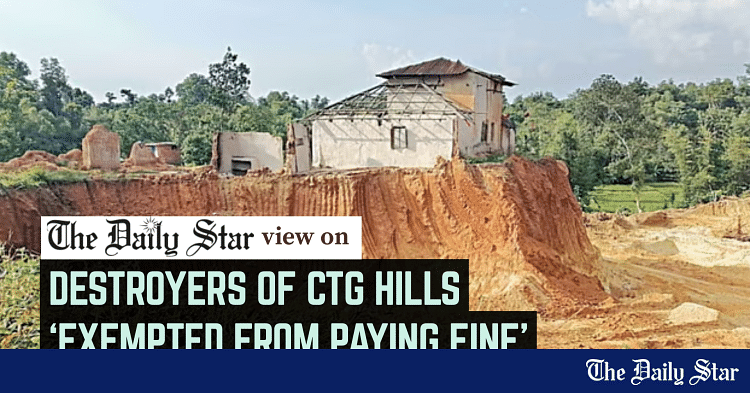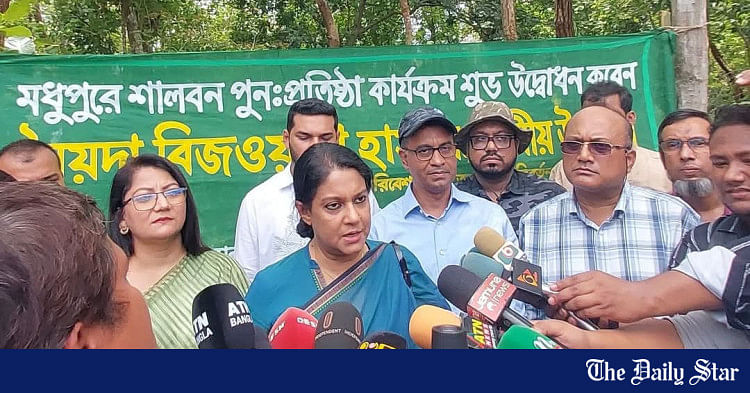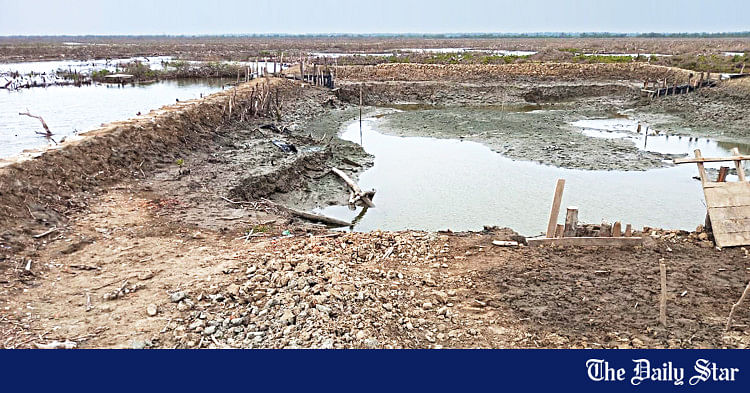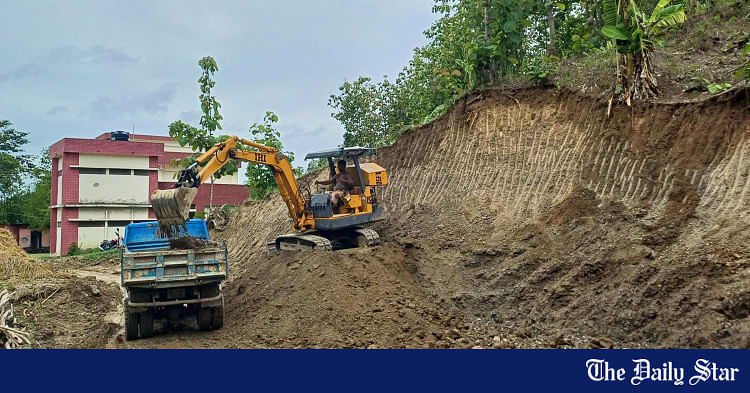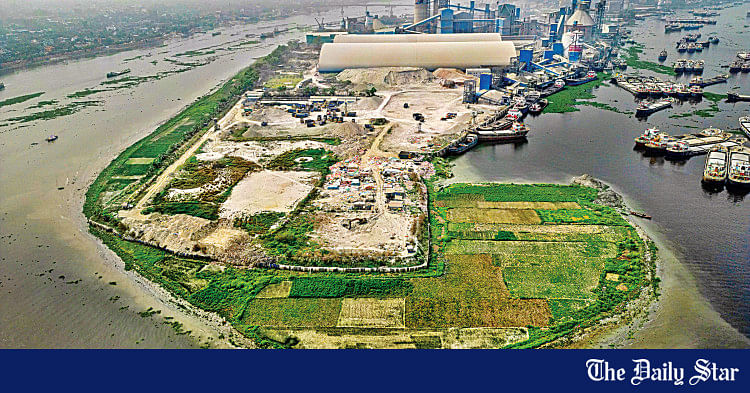- Copy to clipboard
- Thread starter
- #401
Saif
Senior Member
- Joined
- Jan 24, 2024
- Messages
- 15,397
- Reaction score
- 7,873
- Nation

- Residence

- Axis Group


Economy and environment
BANGLADESH’S meandering geographical landscape and low-lying delta topography make it susceptible to natural disasters. However, beyond these geographical challenges, there have been many more casualties, and all of them are directly or indirectly connected to reckless behaviour and flawed...
 www.newagebd.net
www.newagebd.net
Economy and environment
Ummi Hossain 29 April, 2025, 23:06
BANGLADESH’S meandering geographical landscape and low-lying delta topography make it susceptible to natural disasters. However, beyond these geographical challenges, there have been many more casualties, and all of them are directly or indirectly connected to reckless behaviour and flawed thinking frameworks. These problems mainly stem from unsustainable practices.
One of the contributors is the garment industry. More than 84 per cent of Bangladesh’s export earnings are produced in the textile sector. Bangladesh’s ready-made garment exports grew by 7.23 per cent in 2024, reaching $38.48 billion, up from $35.89 billion in 2023, according to the Export Promotion Bureau. On one hand, it is profitable, but on the other hand, it is harmful for our environment. Extreme emissions of carbon dioxide and solid waste are damaging the ecosystem continuously, and industrial wastes are directly polluting the water of the Buriganga, the Shitalakhya, and the Karnafuli River and also lands. Considering the economic advantages and environmental damages of this industry, Bangladesh should attract more eco-friendly systems where economic growth never becomes a barrier to environmental security. This shift in perspective is crucial for the growth and security of Bangladesh from various angles.
Likewise, a further threat is posed by brick kilns, as they are also a fundamental source of air pollution in Bangladesh. In this situation, two possibilities should be considered. First, new alternative technology to construction needs to be introduced; at least actions must be taken against unauthorised brick kilns. According to existing law, if any person makes bricks without obtaining a licence from the district administrator of the district of the brickfield, then he or she shall be punished with imprisonment for not more than one year, with or without a fine which may extend to one lakh taka or both.
Even in Bangladesh, the concerning impact of vehicles on worsening air pollution demands more attention. It not only causes immediate inconvenience in the surroundings but also long-term public health problems like heart diseases, asthma and other lung disorders. Over 235,000 lives were lost due to air pollution in 2021. Children under five years old are especially vulnerable, with health effects including premature birth, low birth weight, asthma and lung diseases.
Besides, there are still many unnecessary personal vehicles driven by gasoline and diesel that create harmful nitrogen dioxide, carbon monoxide, hydrocarbons, benzene, and formaldehyde. According to the Motor Vehicles Ordinance 1983, whoever drives or causes or allows or lets out a motor vehicle for use in any public place, the smoke of which would constitute a health hazard, shall be punishable with a fine which may extend to 200 taka. Police can also seize and detain the vehicle. To deal with this difficult situation, the use of electric battery vehicles should be increased. In the renowned green city of Bangladesh named Rajshahi, this step has already been taken. At first, in 2008, battery-operated autorickshaws were presented in Rajshahi. After getting benefits from it, Rajshahi University of Engineering and Technology again introduced rental e-bikes for personal use, which are very eco-friendly for our environment. The e-bike charge fee is 2 taka per minute. It also helps to sustain the economic growth while promoting environmental security.
It is also important to acknowledge that deforestation is another major critical issue impacting Bangladesh. In 2020, Bangladesh’s natural forests spanned 1.82 million hectares, accounting for 13 per cent of its total land area. By 2023, the country had lost 20.2 thousand hectares of natural forest, leading to 11.6 million tonnes of carbon dioxide emissions. Moreover, Section 33 of the Forest Act 1927 depicts that cutting or dragging any timber shall be punishable with imprisonment for a term which may extend to 5 years and shall not be less than six months and shall be liable to a fine which may extend to Tk 50,000 and not be less than Tk 5,000.
Moreover, Bangladesh has heavy reliance on fossil fuels for its energy security, marked by several challenges, including inefficient energy consumption and environmental concerns. Obviously, it serves as one of the main reasons for the emission of greenhouse gases and further degradation of the environment. On the other hand, the unnecessary use of air conditioning, televisions and other electric devices has increased. In addition to that, many outdated machines in buildings, industries, and transportation are consuming more and more energy. No wonder the reserves of the energy are depleting too. In turn, the mitigation of the environment has become more challenging because of the increased demand for the production of fossil fuel-based energy. Thereby, in an oppositional way, the reliance on diversifying renewable energy sources like solar, wind and hydroelectric power is really significant not only for economic security but also for environmental sustainability.
Furthermore, Bangladesh must consider global collaboration for energy security. It highlights how climate action cannot be isolated. The meaningful partnerships across international boundaries are required not only to secure funds for climate-induced loss and damage but also to foster the innovative, eco-friendly solutions. These solutions, moreover, aim to sustain the economic growth while causing no harm to the environment. Hence, by prioritising sustainability and minimising pollution, Bangladesh can not only enhance its climate resilience but also actively participate in global climate efforts.
Ummi Hossain is an apprentice lawyer at Rajshahi Judge Court.
Ummi Hossain 29 April, 2025, 23:06
BANGLADESH’S meandering geographical landscape and low-lying delta topography make it susceptible to natural disasters. However, beyond these geographical challenges, there have been many more casualties, and all of them are directly or indirectly connected to reckless behaviour and flawed thinking frameworks. These problems mainly stem from unsustainable practices.
One of the contributors is the garment industry. More than 84 per cent of Bangladesh’s export earnings are produced in the textile sector. Bangladesh’s ready-made garment exports grew by 7.23 per cent in 2024, reaching $38.48 billion, up from $35.89 billion in 2023, according to the Export Promotion Bureau. On one hand, it is profitable, but on the other hand, it is harmful for our environment. Extreme emissions of carbon dioxide and solid waste are damaging the ecosystem continuously, and industrial wastes are directly polluting the water of the Buriganga, the Shitalakhya, and the Karnafuli River and also lands. Considering the economic advantages and environmental damages of this industry, Bangladesh should attract more eco-friendly systems where economic growth never becomes a barrier to environmental security. This shift in perspective is crucial for the growth and security of Bangladesh from various angles.
Likewise, a further threat is posed by brick kilns, as they are also a fundamental source of air pollution in Bangladesh. In this situation, two possibilities should be considered. First, new alternative technology to construction needs to be introduced; at least actions must be taken against unauthorised brick kilns. According to existing law, if any person makes bricks without obtaining a licence from the district administrator of the district of the brickfield, then he or she shall be punished with imprisonment for not more than one year, with or without a fine which may extend to one lakh taka or both.
Even in Bangladesh, the concerning impact of vehicles on worsening air pollution demands more attention. It not only causes immediate inconvenience in the surroundings but also long-term public health problems like heart diseases, asthma and other lung disorders. Over 235,000 lives were lost due to air pollution in 2021. Children under five years old are especially vulnerable, with health effects including premature birth, low birth weight, asthma and lung diseases.
Besides, there are still many unnecessary personal vehicles driven by gasoline and diesel that create harmful nitrogen dioxide, carbon monoxide, hydrocarbons, benzene, and formaldehyde. According to the Motor Vehicles Ordinance 1983, whoever drives or causes or allows or lets out a motor vehicle for use in any public place, the smoke of which would constitute a health hazard, shall be punishable with a fine which may extend to 200 taka. Police can also seize and detain the vehicle. To deal with this difficult situation, the use of electric battery vehicles should be increased. In the renowned green city of Bangladesh named Rajshahi, this step has already been taken. At first, in 2008, battery-operated autorickshaws were presented in Rajshahi. After getting benefits from it, Rajshahi University of Engineering and Technology again introduced rental e-bikes for personal use, which are very eco-friendly for our environment. The e-bike charge fee is 2 taka per minute. It also helps to sustain the economic growth while promoting environmental security.
It is also important to acknowledge that deforestation is another major critical issue impacting Bangladesh. In 2020, Bangladesh’s natural forests spanned 1.82 million hectares, accounting for 13 per cent of its total land area. By 2023, the country had lost 20.2 thousand hectares of natural forest, leading to 11.6 million tonnes of carbon dioxide emissions. Moreover, Section 33 of the Forest Act 1927 depicts that cutting or dragging any timber shall be punishable with imprisonment for a term which may extend to 5 years and shall not be less than six months and shall be liable to a fine which may extend to Tk 50,000 and not be less than Tk 5,000.
Moreover, Bangladesh has heavy reliance on fossil fuels for its energy security, marked by several challenges, including inefficient energy consumption and environmental concerns. Obviously, it serves as one of the main reasons for the emission of greenhouse gases and further degradation of the environment. On the other hand, the unnecessary use of air conditioning, televisions and other electric devices has increased. In addition to that, many outdated machines in buildings, industries, and transportation are consuming more and more energy. No wonder the reserves of the energy are depleting too. In turn, the mitigation of the environment has become more challenging because of the increased demand for the production of fossil fuel-based energy. Thereby, in an oppositional way, the reliance on diversifying renewable energy sources like solar, wind and hydroelectric power is really significant not only for economic security but also for environmental sustainability.
Furthermore, Bangladesh must consider global collaboration for energy security. It highlights how climate action cannot be isolated. The meaningful partnerships across international boundaries are required not only to secure funds for climate-induced loss and damage but also to foster the innovative, eco-friendly solutions. These solutions, moreover, aim to sustain the economic growth while causing no harm to the environment. Hence, by prioritising sustainability and minimising pollution, Bangladesh can not only enhance its climate resilience but also actively participate in global climate efforts.
Ummi Hossain is an apprentice lawyer at Rajshahi Judge Court.










